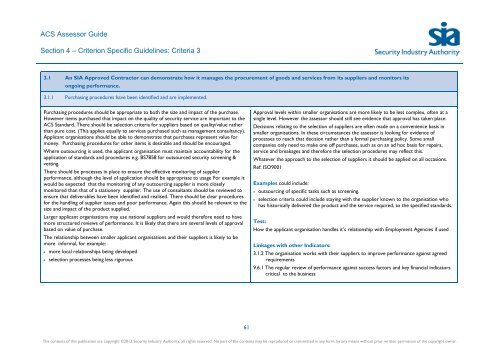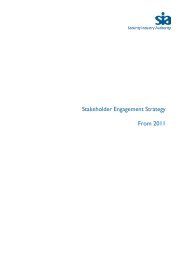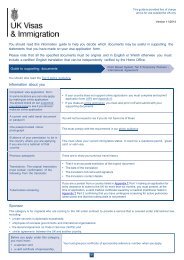ACS Assessor Guide - Security Industry Authority
ACS Assessor Guide - Security Industry Authority
ACS Assessor Guide - Security Industry Authority
Create successful ePaper yourself
Turn your PDF publications into a flip-book with our unique Google optimized e-Paper software.
<strong>ACS</strong> <strong>Assessor</strong> <strong>Guide</strong>Section 4 – Criterion Specific <strong>Guide</strong>lines: Criteria 33.1 An SIA Approved Contractor can demonstrate how it manages the procurement of goods and services from its suppliers and monitors itsongoing performance.3.1.1 Purchasing procedures have been identified and are implemented.Purchasing procedures should be appropriate to both the size and impact of the purchase.However items purchased that impact on the quality of security service are important to the<strong>ACS</strong> Standard. There should be selection criteria for suppliers based on quality/value ratherthan pure cost. (This applies equally to services purchased such as management consultancy).Applicant organisations should be able to demonstrate that purchases represent value formoney. Purchasing procedures for other items is desirable and should be encouraged.Where outsourcing is used, the applicant organisation must maintain accountability for theapplication of standards and procedures e.g. BS7858 for outsourced security screening &vetting.There should be processes in place to ensure the effective monitoring of supplierperformance, although the level of application should be appropriate to usage For example itwould be expected that the monitoring of any outsourcing supplier is more closelymonitored than that of a stationery supplier. The use of consultants should be reviewed toensure that deliverables have been identified and realised. There should be clear proceduresfor the handling of supplier issues and poor performance. Again this should be relevant to thesize and impact of the product supplied.Larger applicant organisations may use national suppliers and would therefore need to havemore structured reviews of performance. It is likely that there are several levels of approvalbased on value of purchase.The relationship between smaller applicant organisations and their suppliers is likely to bemore informal, for example: more local relationships being developed selection processes being less rigorousApproval levels within smaller organisations are more likely to be less complex, often at asingle level. However the assessor should still see evidence that approval has taken place.Decisions relating to the selection of suppliers are often made on a convenience basis insmaller organisations. In these circumstances the assessor is looking for evidence ofprocesses to reach that decision rather than a formal purchasing policy. Some smallcompanies only need to make one off purchases, such as on an ad hoc basis for repairs,service and breakages and therefore the selection procedures may reflect this.Whatever the approach to the selection of suppliers it should be applied on all occasions.Ref: ISO9001Examples could include: outsourcing of specific tasks such as screening. selection criteria could include staying with the supplier known to the organisation whohas historically delivered the product and the service required, to the specified standards.Test:How the applicant organisation handles it’s relationship with Employment Agencies if usedLinkages with other Indicators:3.1.2 The organisation works with their suppliers to improve performance against agreedrequirements9.6.1 The regular review of performance against success factors and key financial indicatorscritical to the business61The contents of this publication are copyright ©2013 <strong>Security</strong> <strong>Industry</strong> <strong>Authority</strong>, all rights reserved. No part of the contents may be reproduced or transmitted in any form, by any means without prior written permission of the copyright owner.
















